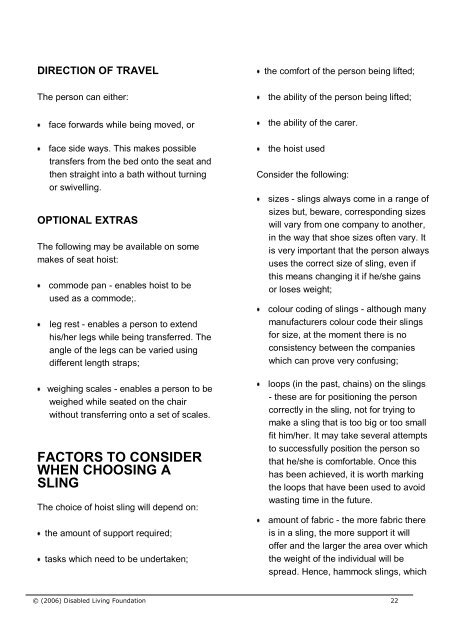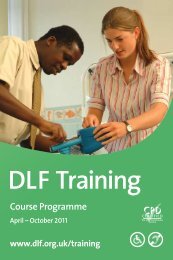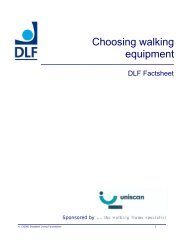DLF Factsheet 'Choosing a Mobile Hoist' - Disabled Living Foundation
DLF Factsheet 'Choosing a Mobile Hoist' - Disabled Living Foundation
DLF Factsheet 'Choosing a Mobile Hoist' - Disabled Living Foundation
You also want an ePaper? Increase the reach of your titles
YUMPU automatically turns print PDFs into web optimized ePapers that Google loves.
DIRECTION OF TRAVEL<br />
The person can either:<br />
face forwards while being moved, or<br />
face side ways. This makes possible<br />
transfers from the bed onto the seat and<br />
then straight into a bath without turning<br />
or swivelling.<br />
OPTIONAL EXTRAS<br />
The following may be available on some<br />
makes of seat hoist:<br />
commode pan - enables hoist to be<br />
used as a commode;.<br />
leg rest - enables a person to extend<br />
his/her legs while being transferred. The<br />
angle of the legs can be varied using<br />
different length straps;<br />
weighing scales - enables a person to be<br />
weighed while seated on the chair<br />
without transferring onto a set of scales.<br />
FACTORS TO CONSIDER<br />
WHEN CHOOSING A<br />
SLING<br />
The choice of hoist sling will depend on:<br />
the amount of support required;<br />
tasks which need to be undertaken;<br />
the comfort of the person being lifted;<br />
the ability of the person being lifted;<br />
the ability of the carer.<br />
the hoist used<br />
Consider the following:<br />
sizes - slings always come in a range of<br />
sizes but, beware, corresponding sizes<br />
will vary from one company to another,<br />
in the way that shoe sizes often vary. It<br />
is very important that the person always<br />
uses the correct size of sling, even if<br />
this means changing it if he/she gains<br />
or loses weight;<br />
colour coding of slings - although many<br />
manufacturers colour code their slings<br />
for size, at the moment there is no<br />
consistency between the companies<br />
which can prove very confusing;<br />
loops (in the past, chains) on the slings<br />
- these are for positioning the person<br />
correctly in the sling, not for trying to<br />
make a sling that is too big or too small<br />
fit him/her. It may take several attempts<br />
to successfully position the person so<br />
that he/she is comfortable. Once this<br />
has been achieved, it is worth marking<br />
the loops that have been used to avoid<br />
wasting time in the future.<br />
amount of fabric - the more fabric there<br />
is in a sling, the more support it will<br />
offer and the larger the area over which<br />
the weight of the individual will be<br />
spread. Hence, hammock slings, which<br />
© (2006) <strong>Disabled</strong> <strong>Living</strong> <strong>Foundation</strong> 22
















